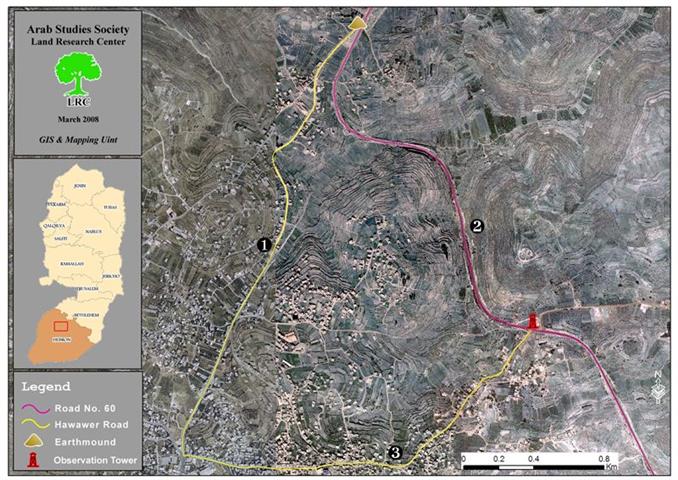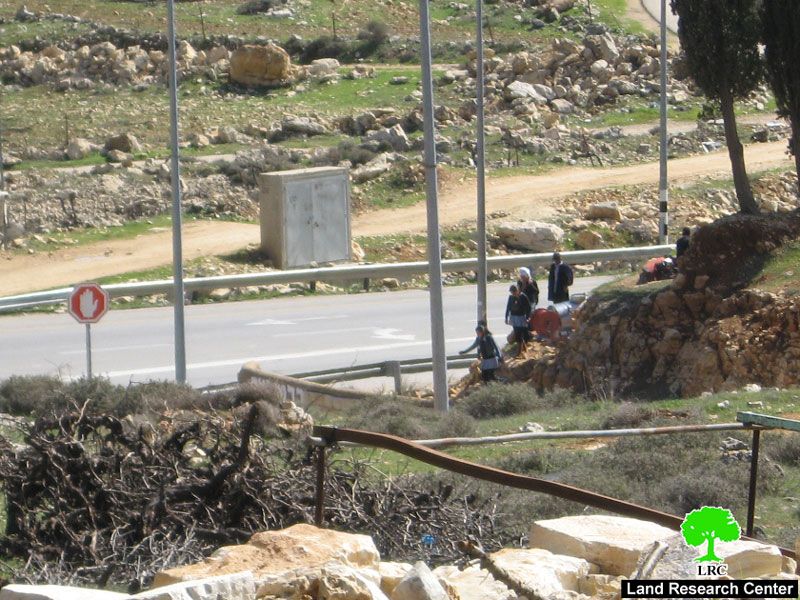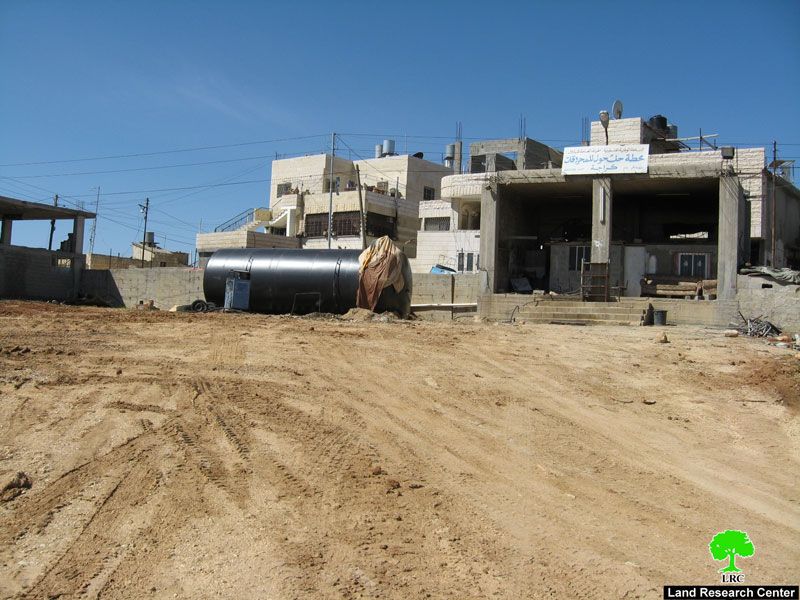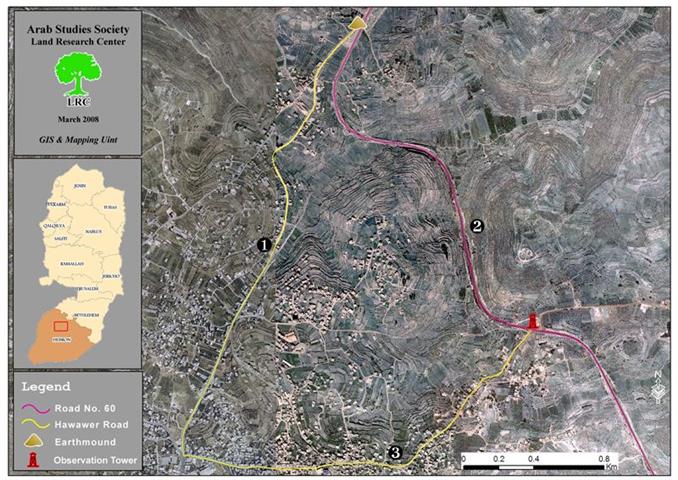Al Hawawer Road is considered to be the northern main entrance for the Governorate of Hebron. It is located north of the town of Halhul and it connects Halhul with all of the towns north and north-east of it. In addition, it is the only connecting road between the City of Hebron and the cities of Bethlehem and Jerusalem via Road 60.
Map 1: An aerial photo depicting Al Hawawer entrance
-
The distance between Al Hawawer earthmound to Al Nabi Younis triangle is 2,821 meters.
-
The distance between Al Hawawer earthmound and the military checkpoint on Road 60 is 2,434 meters.
-
The distance between Al Nabi Younis triangle and Al Nabi Younis checkpoint is 2,372 meters.
As such, the distance Palestinians living in Al Hawawer neighborhood are obliged to cover to reach the point beyond the earthmound is about 7,627 meters while Palestinians from Hebron heading towards Bethlehem (and vise-a-versa) are obliged to travel an additional 1,985 meters.
Description of the Entrance:-
Al Hawarer entrance used to be on the main road connecting between the town of Halhul and the city of Hebron. However, in 1996 Israeli authorities established By-Pass Road 60 parallel to the main road which rendered it unexpandable. The goal behind the establishment of the by-pass road was to connect Israeli colonies in Bethlehem with the colonies of Kiryat Arba, Karmi Tzur, Kharsina, Karmel and Ma’on among other colonies in Hebron Governorate.
The Violation:
Since the beginning of the year 2001 until the present time Israeli occupation forces have been closing down Al Hawawer entrance with large amounts of sand and rubble taken from nearby Palestinian lands. These forces, also, made a large ditch in the vicinity of the earthmound as to make it impossible for Palestinian vehicles to by-pass the earthmound.
Photo 1: Al Hawawer Entrance
Photo 2: Al Hawawere Street: vacant after the closure
The Effect of Al Hawawer Closure on the Governorate of Hebron:
As it used to be the main road connecting between the town of Halhul and each of Beit Ummar, Surif and Al Arrub Refugee Camp, the closure of this entry point had negatively affected the lives of Palestinians in a number of fields including the following:
A) Education: hundreds of students from Hebron Governorate study in Bethlehem University and the Technical College in Al Arrub. These two educational institutions are located beyond the earthmound. Moreover, there are tens of students from Bethlehem who attend Hebron and the Polytechnic Universities in Hebron city who have been negatively affected by the closure. Land Research Center’s field researcher has conducted a number of interviews with some of the students and employees of these institutions. Some of these interviews are listed below:
A female student at the Technical College expressed the following: 'I am obliged to wake up earlier so I can get to my classes on time as we currently have to go through Al Nabi Younis rather than Al Hawawer. Transportation costs have doubled as well as the time it takes to reach the College. The closure at Al Hawawer is a source of agony to us. '
As for Huda, a fifth grader, whose house is located beyond the closure which forces her to use the by-pass Road 60 to reach her school, she indicated the following: ' The school bus used to come to the doorsteps of my house to take me to school. Nowadays, I have to go on foot to my school across the Death Road. I recite a lot of prayers every time I see an Israeli car coming my way as Israeli drivers make scary moves in their cars. I think they do that on purpose to instill fear in us. '
Photo 3: Female students trying to cross the “Death Road” to reach their houses
Photo 4: A child crossing Al Hahawer on foot due to the closure.
An employee at Hebron University who lives beyond the closure and in parallel to the by-pass road said the following: ' We are really suffering because of the closure especially that our house is located beyond it. This means that we have to use an alternative dirt road that fills us with mud in the winter and dirt in the summer. In addition, we are forced to walk long distances to reach our desired destinations. We, also, would have to wait for hours before a taxi would reach us near the closure. We are really suffering and nobody cares for us. '
B) Internal Commerce: The market in the City of Hebron is the only one for the farmers of the northern villages in which they market their agricultural products. Moreover, this market is where they shop for their other needs including electrical appliances, clothes, building materials, food items, among other items. A farmer from the town of Beit Ummar explained to the researcher the effect the closure had on farmers in the town:
The closure caused a great deal of damage to us especially that we currently walk twice the distance that we used to take in the past. The increase in the transportation cost has increased our suffering. We are forced to use Al Nabi Younis-Halhul Road as it is the only road leading into Hebron. Traffic jams are frequent on that road especially in the mornings. When we go to market our goods in the city of Hebron, we reach our destination late which causes us financial losses as merchants would have already bought their fruits and vegetables from other farmers.
C) Workforce: hundreds of Palestinian workers from Hebron used to use Al Hawawer road to reach the cities of Bethlehem and Jerusalem. The closure of Al Hawawer has forced them to change their daily route leading them to reach their working stations late. One of the employees in the city of Bethlehem who lives near the closure indicated the following: 'When I go to Bethlehem I usually take a dirt road, stand on Road 60 waiting for a ride. When I go back home, I have to travel a distance of about 8 kilometers rather than tens of meters because of the earthmound; I will be obliged to reach the center of the town of Halhul and then head northwards to reach my home. This detour makes me usually arrive at home late and costs me additional transportation fees.'
D) Agriculture: The presence of the earthmound has caused a great damage to the lands located beyond it and near the by-pass road as it prevents farmers from reaching their lands. Moreover, farmers cannot get their tractors or animals into their lands to plow it. This has led hundreds of dunums in the vicinity of the earthmound to become useless and unsuitable for agricultural purposes any more. One of the most affected farmers by the earthmound is Abdel Hadi who stated the following: ' Upon the creation of the earthmound, Israeli soldiers plowed my land and used its soil to reinforce the closure. When I brought heavy machinery to try and fix what the soldiers have damaged, I was surprised when an Israeli patrol showed up and prevented me from working in the land. The soldiers also threatened that they will confiscate the heavy machinery in case that I continued to use it. I own 10 dunums in that area that I am prevented from rehabilitating it. I am only allowed to plow it by hand despite the fact that it needs heavy machinery due to long periods of neglect which made the land uneven and hard to work on. '
Photo 5: The remaining land that belongs to Mr. Abdel Hadi.
Al Hawawer Neighborhood Residents Live the Tragedy Caused by the Closure:
The neighborhood of Al Hawawer is located north of the town of Halhul near the colony of Karmi Tzur. Around 500 people live in the neighborhood and they are continuously suffering due to the closure at Al Hawawer entrance as well as due to the presence of by-pass Road 60. The neighborhood lacks any medical clinics, kindergartens and shops while securing transportation is a daily dilemma. Before the earthmound was erected, the neighborhood used to be on the main line connecting Halhul and Hebron with the cities and governorates in the north. A large number of workshops, stores in addition to a gas station used to be active in the neighborhood. Nowadays, most of them have shut down due to lack of business as a direct result of the creation of the closure at the entrance of the neighborhood.
The residents of the neighborhood, especially those residing in Khirbat Aqel, Wadi Muheisan and in parallel to the by-pass road, suffer from the lack of transportation in addition to the fact that they live in total social isolation. Families living in such isolation include Karajat, Aqel, Muheisen, Karaja, Al Badawi and Abu Rmeishan.
Photo 6: Khirbet Aqel is totally isolated due to the earthmound.
Hajja Fatima, a resident of the neighborhood, said: ' This closure is causing us great anguish. We are elderly and we cannot walk. When I have to walk, I find myself having to sit at the edge of the street every so often to take a rest. I am sick and I can’t walk long distances.'
Land Research Center has also visited a number of families affected by the closure including the family of Mr. Ayyoub Karajat who live on a hill facing the colony of Karmi Tzur from its western direction while the house faces an Israeli military camp from its southern direction. His house also overlooks the by-pass Road 60 from its eastern direction while a vacant plot of land surrounds the house from its northern direction. As such, the residents of the house (n=8) live in agony as Israeli soldiers prevent them from wandering around their house under the pretext of providing security for the colonists. The by-pass Road 60 has also caused them great damages especially after the creation of the closure; Israeli occupation forces placed cement blocks at the entrance of the house in 2001. When the residents protested and tried to remove the blocks, Israeli soldiers rushed into the house and told them that if the residents wanted to remove the blocks, a gate would have to be installed instead. Umm Mohammad, a resident of the house expressed the following to LRC’s field worker: ' Our presence in the house is endangering our lives. We are surrounded by the by-pass road, the camp and the colony. I see and feel death on daily basis especially when I hear the sounds of the brakes of colonists’ cars. My mind would automatically think of my girls who go to their school on foot on daily basis. Since the beginning of the Intifada colonists’ attacks against us have increased dramatically. Moreover, my girls are continually complaining about Israeli drivers who purposefully get close to them with their cars while trying to cross the by-pass. I thank God every time they come home safely. '
Umm Mohammad continued her testimony by saying: ' Our distress is not limited to the movement of the students; when we try to buy any of the house necessities (such as gas canisters, flour, sugar, rice, etc) we would be obliged to carry it for long distances to reach home. Also, when a member of my family gets sick we would be obliged to walk around 4 kilometers to reach the center of the town as we don’t have any clinics in the vicinity of the of our neighborhood. In the evenings we lock our doors in fear. We try to do all what needs to be done during the day time. Our relatives are not visiting us anymore. As such, we live in total isolation because of the earthmound. '
Photo 7: The house of Mr. Ayyoub Karajat
Photo 8: The iron gate Israeli soldiers forced Mr. Karajat to install.
Photo A: The colony of Karmi Tzur faces the house from its western direction.
Photo B: The Israeli military camp faces the house from its southern direction.
Photo C: The by-pass Road 60 faces the house from its eastern direction.
Photo D: No building in allowed on this land
The case of the family of Mr. Rateb Al Badawi:
The house of Al Badawi family is located between the by-pass road and the main road upon which the earthmound was placed. Israeli occupation forces prevent the family from building or expanding their current house under the pretext that it is located in an area classified as Area C. At the beginning of 2006, Israeli occupation forces came to the Badawi residence and gave him a “Stop Work” Order on an addition to the house in which the son of Mr. Al Badawi was supposed to live in with his family. Since then, the house stayed as is without being finished. Moreover, occupation forces instructed Mr. Al Badawi to shut the windows overlooking the colony permanently.
Photo 9: The part of the house that was issued a Stop Work order.
Photo 10: the closed off windows.
On the economical front, the earthmound has led to the closure of a large number of workshops and stores. Mr. Abdel Hadi Abu Rmeishan is a store owner in the neighborhood. He indicated the following: ' Before the earthmound was created by the occupation forces I used to open my store at 4:00 AM and close it at 10:00 PM. Currently, I open it at as late at 10:00 AM and close it at 5:00 PM as sales have sharply plummeted. I used to make more than NIS 1,000 on daily basis. Nowadays, I would be lucky if I made NIS 200 a day. Moreover, I used to have two stores; one of them I used to sell meat and chicken while the second one I used as a grocery shop. After the earthmound was created I was forced to close down the first store due to losses and debts. Look, my store is empty except of few basic items. I usually destroy a large number of cans as they would expire before people would buy it. I don’t know what to do. I have two girls in the university. I made one of them quit school despite the fact that she was doing well in it due to the economic decline of the shops. My one shop can barely meet the needs of my 8-member family. '
Photo 11: The store of Mr. Abu Rmeishan
Also, the owner of Al Iqtisad Mechanical Workshop gave the following statement: ' I have no work here. I just come to waste time. Since the closure, we’ve been in a steep economic decline. There is no income. Look at us; instead of the workers working on cars, they are just sitting around bored and in despair. Also, due to the lack of customers, debts have been piling up till it reached almost $30,000. We have become sick due to our constant worries about our debts. We call upon all of human rights organizations to push for the removal of the closure that is choking us. '
Photo 12: Al Iqtisad Garage – lacks customers and tools.
As for Mr. Maher Karaja, he owns a gas station in the neighborhood. He gave the following statement: ' I owned a gas station. When the earthmound was not present, I used to have plenty of customers as this road used to be a main road. After the closure, a car would pass once every three hours. I was providing fuel from the Israeli company but no one would buy it. I became loaded with debt and loses in thousands of dollars. '
Photo 13: Halhul gas station in Al Hawawer – shut down due to closure.
What to Do?
Thousands of citizens, school and university students, farmers and workers are obliged to take an additional 4 kilometers detour to reach the northern entrance of the town of Halhul (Al Nabi Younis junction). The junction is controlled by a stationary Israeli checkpoint with a gate that is closed down more frequently which causes traffic jams affecting all aspects of Palestinian life. Two additional kilometers have to be crossed from the junction until people can reach the center of the town of Halhul.
In terms of truck movement, the increased distance meant an increase in transportation costs and time which led to the increase in the prices of the transported commodities. This price hike has affected more than half a million people living in the Governorate of Hebron.
What Next?
The closure is in violation of all international laws and norms and is in direct contradiction with the Geneva conventions. Israeli checkpoints and closures have become an excuse to protect the colonists living illegally in the West Bank. By-pass roads have become death streets for the Palestinians and places of security and safety for the colonists. Israeli occupation forces have provided security for strangers in a land that does not belong to them.
The Land Research Center denounces the closure of Al Hawawer entrance and warns against the continuation of the Israeli policy of collective punishment. The Center demands that the earthmound to be removed and dismantled immediately. It also calls upon the leaders of the world, especially in the European Union, to pressure the Israeli government to remove the closure and the other 700+ closures that segregates between Palestinian towns, cities and villages.
Prepared by:
The Land Research Center
LRC
































